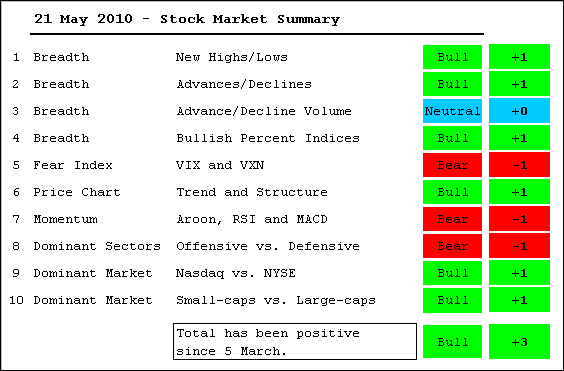How can the evidence remain bullish after the April-May decline? Looking back at the evidence in early February, which turned negative after the Jan-Feb pullback, these are the indicator that turned bearish: the McClellan Oscillators, the S&P 500 Volatility Index ($VIX), momentum, offensive sector performance, small-cap performance and Dollar/Bond performance. Today, only three of ten indicators are bearish. We have bearish readings for the S&P 500 Volatility Index ($VIX), momentum and offensive sector performance. The AD Lines hit new highs in April and remain above their February lows. In addition, the major index ETFs hit new highs in April and remain above their February lows. This is why breadth and trend remain bullish. Net New Highs could turn bearish soon if the 10-day SMA turns negative. The NYSE AD Volume Line broke its February low. The goal of this table is to hold up during corrections and turn negative when a correction overstays its welcome. I suspect that it will take a break below the February lows to turn the evidence bearish. Indicator details after the jump.
- AD Lines: Bullish. The Nasdaq and NYSE AD Lines recorded new 52-week highs in April and remain well above their February lows.
- AD Volume Lines: Neutral. The Nasdaq AD Volume Line remains well above its February low, but the NYSE AD Volume Line broke below this key low.
- Net New Highs: Bullish. The 10-day SMA for Net New Highs remains barely positive for both the Nasdaq and NYSE. It is the moment-of-truth for this indicator.
- Bullish Percent Indices: Bullish. BPIs for the major indices remain above 50%. Five of the nine sectors have BPIs above 50%. The S&P 100 ($OEX) is at 51%. This lagging indicator still favors the bulls.
- Sentiment: Bearish. The S&P 500 Volatility Index ($VIX) and Nasdaq 100 Volatility Index ($VXN) clearly broke resistance to start long-term uptrends in volatility.
- Trend Structure: Bullish. The major index ETFs all recorded new 52-week highs in April and have yet to break their February lows.
- SPY Momentum: Bearish. The Aroon Oscillator and MACD (5,35,5) remain in negative territory. RSI broke below 50.
- Offensive Sector Performance: Bearish. The finance, industrials and consumer discretionary sectors show relative weakness over the last four weeks.
- Nasdaq Performance: Bullish. The Nasdaq continues to hold up better than the NY Composite as the $COMPQ:$NYA ratio trends higher.
- Small-caps Performance: Bullish. Small-caps are outperforming large-caps as the IWM:OEF ratio trends higher.
- Breadth charts have been updated.

About the author:
Arthur Hill, CMT, is the Chief Technical Strategist at TrendInvestorPro.com. Focusing predominantly on US equities and ETFs, his systematic approach of identifying trend, finding signals within the trend, and setting key price levels has made him an esteemed market technician. Arthur has written articles for numerous financial publications including Barrons and Stocks & Commodities Magazine. In addition to his Chartered Market Technician (CMT) designation, he holds an MBA from the Cass Business School at City University in London.
Learn More
